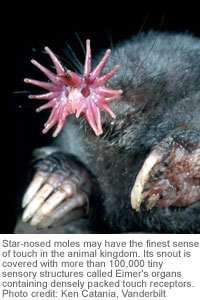A scientist probes the origins of 'ouch!'

Skinning a knee, swallowing habanero salsa, and installing snow chains bare-handed might seem pretty different at first. But all have one thing in common -- they're guaranteed to hurt.
The ability to detect such noxious stimuli is known as nociception. While critical for avoiding injury, nociception is also the bane of thousands of cancer, HIV, and spinal cord injury patients. Many develop hypersensitivity to pain, making a soft caress or light breeze excruciating.
Though pain is a widespread problem, says Berkeley professor of cell and developmental biology Diana Bautista, "we know very little about the basic molecular mechanisms behind nociception."
What scientists do know is that our neurons detect noxious stimuli with the help of molecular receptors. Bautista works to identify these receptors, and describes how they relay messages of heat, cold, chemical irritants and touch to the brain.
In her laboratory, Bautista exposes naked pain neurons to strongly-flavored natural compounds. Garlic, chilies, mints and other plants produce these substances to stimulate pain in animals and repel would-be browsers. As a result, Bautista's stash of reagents bears far more resemblance to a pantry than a lab bench. Her lab is stocked with tins of peppermint and cinnamon lozenges, bottles of peppers, cloves of garlic and tubes of wasabi.
"We isolate the active compounds in these foods, and look to see which subtypes of somatosensory neurons are activated. Are they targeting heat sensitive, touch sensitive or cold sensitive neurons? This gives us hints on how they function," Bautista says.
For example, the sinus burning that accompanies wasabi and mustard is caused by a compound called allyl isothiocyanate. In high doses, it causes swelling, redness and hypersensitivity to heat and touch.
Bautista discovered that mustard oil interacts with a pain receptor called TRPA1. To prove TRPA1 was indeed associated with mustard oil irritation, she engineered mice that lack the receptor gene. As expected, the mice failed to raise an inflammatory response when exposed to mustard, garlic or wasabi.
The same receptor triggers coughing and asthma attacks, and is at least partly responsible for hypersensitivity that develops after nerve injury or inflammation. For this reason, every major pharmaceutical company in the world is now investigating TRPA1 to find drugs fighting asthma, airway inflammation and pain.
Still other natural products, like morphine from opium poppies and aspirin from willow bark, alleviate pain. Less well known is a remedy for toothache used in traditional Chinese medicine. Chew the dried berries of the Sichuan pepper, and a numbing, tingling sensation will accompany their vaguely citrus flavor. Native American healers use a similar strategy -brewing the bark of a related plant they call the "toothache tree," or American prickly ash, into tea.
"Figuring out how the active component interacts with the somatosensory system might lead us to an important molecule we can target to alleviate pain," Bautista says.
The molecule responsible for Sichuan pepper's effects is hydroxy-alpha-sanshool. Bautista first traced sanshool's effects to a type of potassium channel. Additional experiments narrowed the field to three related receptors known to interact with anesthetics. Of those, the KCNK18 receptor is expressed at high levels by somatosensory neurons. Bautista suspects that when KCNK18 is activated, it serves as a sensory gatekeeper, regulating the forwarding of pain signals to the brain. She is now pursuing this hypothesis by studying mutant mice lacking this channel.
Sensing mechanical pressure, however, is a whole other ballgame. "Compared to other sensory systems, our sense of touch is the most mysterious," Bautista says. The main problem: it's difficult to study. Sensory neurons are usually sparsely distributed and therefore tricky to isolate.
Bautista looked to Mother Nature for an answer. She found what she was looking for in the star-nosed mole. Named for the fleshy, tentacled organ that graces its snout, this mole makes its living tunneling through swampy East Coast soils, snarfing up worms, bugs and other soil organisms along the way. Though the star is less than half an inch across, it's packed with ten times more sensory neurons than the human hand.
"Instead of trying to figure out how to isolate large quantities of touch receptors from the skin, nature's done it for us," Bautista says. There is one downside to mole dependence, however. It won't breed in captivity, forcing Bautista to acquire a few unexpected job skills. "Most of my scientific life has been spent in a dark room doing fluorescence imaging on a microscope. But now, once or twice a summer, I go to rural Pennsylvania, put on waders, and trap moles" alongside her collaborator and star-nosed mole behavior expert Ken Catania of Vanderbilt University.
Bautista is now examining the genes expressed in the star's sensory neurons to determine what receptors make this organ so sensitive. "The idea is to come up with new candidate molecules important in touch sensation. Then we can look at those candidates in mouse and human tissue to see what role they play in normal somatosensory function," Bautista says.
Ultimately, Bautista hopes to identify good drug targets for pain therapies. Current drugs for acute pain all affect brain processing, making patients woozy and often leading to addiction. Those acting on nociceptors might sidestep these problems, and make chronic, maladaptive pain a thing of the past.
Source: University of California, Berkeley


















